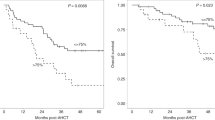Abstract
The objective of this study was to evaluate immunophenotypic profile along with clinical follow-up in patients with advanced stage mantle cell lymphoma (MCL), and their possible influence on overall survival (OS). Bone marrow (BM) cell and/or peripheral blood mononuclear cell flow cytometric analyses of the following antigens were performed: HLA–DR, CD19, CD20, CD22, CD23, CD25, CD10, SmIg, kappa, lambda, CD79b, CD38, FMC7, CD3, CD2, and CD5. There were 14 patients in IV CS, and 26 patients in CS V. All patients were treated with CHOP. Immunological markers showed a typical phenotype (CD5+ CD23-, Cyclin D1) in all cases. Pathohystological type of BM infiltration was predominantly diffuse (72.5%), and in remainder of patients, nodular. Comparison of patients with leukemic phase of MCL with CSIV (BM), has shown significantly higher expression of CD19, CD20, and CD23, followed by permanently negative expression of CD23. Patients with blastic variant of MCL had higher expression of CD23, compared to typical MCL (P < 0.001). Median OS was 20 months, and there were no significant OS-differences between CS IV and leukemic phase patients. Survival analyses showed that negative prognostic influence had high IPI (P < 0.01), presence of extranodal localization (P < 0.01), and diffuse type of BM involvement (P < 0.01). Using Cox regression according to OS, IPI had independent prognostic value (P < 0.001). Our results demonstrated that in the advanced MCL patients the most powerful prognostic factor was IPI, while extranodal localization and type of BM infiltration were of a limited value.






Similar content being viewed by others
References
Harris NL, et al. A revised European–American classification of lymphoid neoplasms: a proposal from the International Lymphoma Study Group. Blood 1994;84:1361–92.
Raffeld M, Jaffe ES. Bcl–1, t (11; 14), and mantle cell–derived lymphomas. Blood 1991;78:259–63.
Cordell JL, et al. Immunoenzymatic labeling of monoclonal antibodies using immune complexes of alkaline phosphatase and monoclonal anti–alkaline phosphatese (APAAP–complexes). J Histoch Cytochem 1984;32:219–29.
Wohlschlaeger CH, Lange HM, Feller AC. Aberrant immunophenotypes of mantle cell lymphomas. Leuk Lymphoma 2003;44:269–73.
Matutes E, et al. The leukemic presentation of mantle–cell lymphoma: disease features and prognostic factors in 58 patients. Leuk Lymphoma 2004;45:2007–15.
Weisenburger DD, Armitage JO. Mantle cell lymphoma; an entity comes of age. Blood 1996;87:4483–94.
Donfrid–Todorovic M, et al. Monocytoid B cell lymphoma associated with antibodies to myelin–associated glycoprotein and sulphated glucuronyl paragloboside. Acta Haematol 2001;106:130–2.
Rodig SJ, et al. Mantle cell lymphoma arising within primary nodal marginal zone lymphoma: a unique presentation of two uncommon B–cell lymphoproliferative disorders. Cancer Genet Cytogenet 2006;171:44–51.
Pittaluga S, et al. Prognostic significance of bone marrow trephine biopsy and peripheral blood smears in 55 patients with mantle cell lymphoma. Leuk Lymphoma 1996;21:115–25.
Samaha H, et al. Mantle cell lymphoma: a retrospective study of 121 cases. Leukemia 1998;12:1281–7.
Bosch F, et al. Mantle cell lymphoma: presenting features, response to therapy, and prognostic factors. Cancer 1998;82:567–75.
Cohen PL, Kurtin PJ, Donovan KA, Hanson CA. Bone marrow and peripheral blood involvement in mantle cell lymphoma. Br J Haematol 1998;101:302–10.
Chuang SS, et al. Mantle cell lymphoma in Taiwan: clinicopathological and molecular study of 21 cases including one cyclin D1–negative tumor expressing cyclin D2. Pathol Int 2006;56:440–8.
Zhang L, Kern WF, Yu Z, Mulvihill JJ. Li. Cryptic and complex chromosomal rearrangements and the deletion of TP53. Cancer Genet Cytogenet 2006;169:169–73.
Yin CC, et al. Sequence analysis proves clonal identity in five patients with typical and blastoid mantle cell lymphoma. Mod Pathol 2007;20:1–7.
Parrens M, et al. Blastoid and common variants of mantle cell lymphoma exhibit distinct immunophenotypic and interphase FISH features. Histopathology 2006;48:353–62.
Sarfati M, Fournier S, Wu CY, Delespesse G. Expression, regulation and function of human Fc epsilon RII (CD23) antigen. Immunol Res 1992;11:260–72.
Prinz JC, Baur X, Mazur G, Rieber EP. Allergen–directed expression of Fc receptors for IgE (CD23) on human T lymphocytes is modulated by interleukin 4 and interferon–gamma. Eur J Immuno 1990;20:1259–64.
Reljic R, Cosentino G, Gould HJ. Function of CD23 in the response of human B cells to antigen. Eur J Immunol 1997;27:572–5.
Lai R, et al. Immunoglobulin VH somatic hypermutation in mantle cell lymphoma: mutated. Mod Pathol 2006;19:1498–05.
Salar A, et al. Gastrointestinal involvement in mantle cell lymphoma: a prospective clinic, endoscopic, and pathologic study. Am J Surg Pathol 2006;30:1274–80.
Nickenig C, et al. German Low–Grade Lymphoma Study Group. Combined cyclophosphamide, vincristine, doxorubicin, and prednisone (CHOP) improves response rates but not survival and has lower hematologic toxicity compared with combined mitoxantrone, chlorambucil, and prednisone (MCP) in follicular and mantle cell lymphomas: results of a prospective randomized trial of the German Low–Grade Lymphoma Study Group. Cancer 2006;107:1014–22.
Ritchie DS, et al. The hyper–CVAD–rituximab chemotherapy programme followed by high–dose busulfan, melphalan and autologous stem cell transplantation produces excellent event–free survival in patients with previously untreated mantle cell lymphoma. Ann Hematol 2007;86:101–5.
Author information
Authors and Affiliations
Corresponding author
Rights and permissions
About this article
Cite this article
Todorovic, M., Pavlovic, M., Balint, B. et al. Immunophenotypic profile and clinical characteristics in patients with advanced stage mantle cell lymphoma. Med Oncol 24, 413–418 (2007). https://doi.org/10.1007/s12032-007-0029-5
Received:
Accepted:
Published:
Issue Date:
DOI: https://doi.org/10.1007/s12032-007-0029-5




